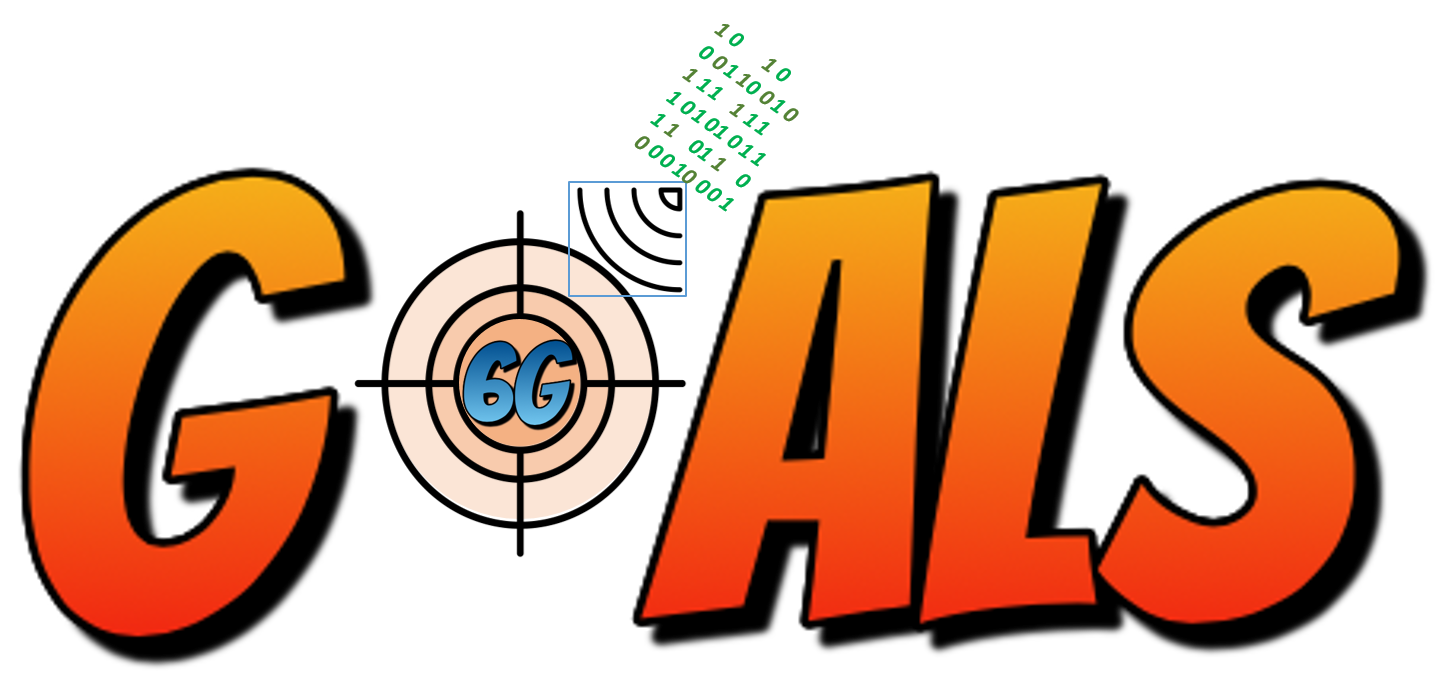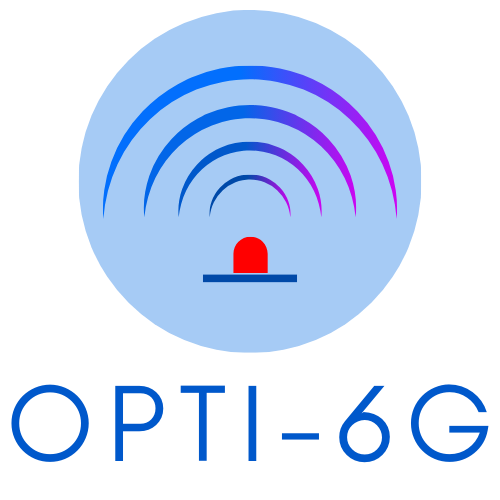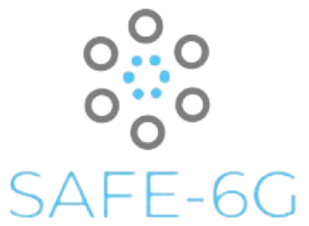Wireless Communication Technologies and Signal Processing
Stream B (2023): Covers research for revolutionary technology advancements, in preparation for 6G and revolutionary advancements of IoT, devices and software. This Stream targets low to medium TRL in WP2023, with the objective of delivering innovative solutions towards real life networks in a long-term time-period. It also includes targeted international cooperation with the USA centred on Artificial Intelligence.
B-01-01: System Architecture
Project Mission
Service-based architecture in the 5G core network, disaggregated RAN, and network slicing are a few of the 5G network’s innovative paradigms. There are however new requirements for 6G, such as the efficient use of integrated cloud resources, end-to-end network programmability, and the dynamic integration of multiple connectivity domains to realize intelligent connectivity across increasingly pervasive cloud environments. The 6G-Cloud project will research, develop, and validate key technologies to realize an artificial intelligence (AI)-native and cloud-friendly system architecture atop the cloud continuum. It will integrate cloud resources offered by multiple stakeholders and allow network functions from different 6G network segments to be composed flexibly and dynamically based on service needs in hybrid cloud environments. 6G-Cloud will address the following key topics: i) designing a holistic, AI-native service-oriented 6G system architecture atop a cloud continuum; ii) developing AI-driven cloud continuum and management frameworks and business interfaces for a multistakeholder environment; iii) defining an AI/machine learning (ML) framework for native-AI support in the 6G system; iv) supporting the 6G “network-of networks” concept using service-oriented network design. 6G-Cloud will incorporate scalability, sustainability, resilience, and security requirements into the system design. The concept will be validated by three well-defined proofs of-concept and promoted through 6G architectural standardization work and open-source projects to reach
maximum impact.
Contact Details
Website: https://www.6g-cloud.eu/ Social Media: ![]()
![]()
![]()
Project Coordinator: Tao Chen, VTT Technical Research Centre of Finland
Contribution to the SNS JU Journal 2025
Participants
- TEKNOLOGIAN TUTKIMUSKESKUS VTT OY, FI
- NATIONAL CENTER FOR SCIENTIFIC RESEARCH “DEMOKRITOS”, EL
- UNIVERSIDAD DE MURCIA, ES
- POLITECHNIKA WARSZAWSKA, PL
- ORANGE POLSKA SPOLKA AKCYJNA, PL
- ATOS IT SOLUTIONS AND SERVICES IBERIA SL, ES
- BULL SAS, FR
- THALES SIX GTS FRANCE SAS, FR
- LENOVO DEUTSCHLAND GMBH, DE
- BubbleRAN, FR
- UBIWHERE LDA, PT
- FOUR DOT INFINITY INFORMATION AND TELECOMMUNICATIONS SOLUTIONS Private Company, EL
- UNIVERSITAET BERN, CH
Project Mission
The 6G Smart Networks of the future will provide the high-performance and energy-efficient infrastructure on which next generation internet and other services can be developed and deployed. 6G will foster an Industry revolution and digital transformation and will accelerate the building of smart societies leading to quality-of-life improvements, facilitating autonomous systems, haptic communication and smart healthcare. To achieve the aforementioned objectives in a sustainable way, it is well understood that new approaches are needed in the way the telco infrastructures are architected, federated and orchestrated. These new approaches call for multistakeholder ecosystems that promote synergies among MNOs and owners of all kinds or computational and networking resources that will share the extraordinary costs of yet another generation upgrade from 5G to 6G, while facilitating new business models. It is clear, that the new architecture paradigms bring unprecedented complexity due to the sheer scale and heterogeneity of the orchestration domains involved, that should be matched by equally capable automation capabilities, thus 6G is aiming for the “holy grail” of pervasive AI-driven intelligence, termed as Native AI. However, the multi-stakeholder infrastructures foreseen in 6G as per the “network of networks” concept, will add a level of unprecedented management complexity due to the sheer scale and heterogeneity of the orchestration domains involved. 6G-INTENSE aims to abstract and federate all kinds of computational and communication resources under an internet-scale framework, that is governed by an intelligent orchestration paradigm, termed as DIMO.
Contact Details
Website: https://6g-intense.eu/ Social Media: ![]()
![]()
![]()
Project Coordinator: Christos Verikousis (ISI/ATH)
Contribution to the SNS JU Journal 2025
Participants
- ATHINA-EREVNITIKO KENTRO KAINOTOMIAS STIS TECHNOLOGIES TIS PLIROFORIAS, TON EPIKOINONION KAI TIS GNOSIS, EL
- EURECOM GIE, FR
- L.M. ERICSSON LIMITED, IE
- INTRACOM SA TELECOM SOLUTIONS, EL
- ORANGE ROMANIA SA, RO
- ORGANISMOS TILEPIKOINONION TIS ELLADOS OTE AE, EL
- CONSORZIO NAZIONALE INTERUNIVERSITARIO PER LE TELECOMUNICAZIONI, IT
- IQUADRAT INFORMATICA SL, ES
- OULUN YLIOPISTO, FI
- EBOS TECHNOLOGIES LIMITED, CY
- SC REALWORLD EASTERN EUROPE SRL, RO

Project Mission
The overarching objective of 6G-TWIN is to provide the foundation for the design, implementation and validation of an AI-native reference architecture for 6G systems that incorporates Network Digital Twins (NDT) as a core mechanism for the end-to-end, real-time optimisation, management and control of highly dynamic and complex network scenarios. To achieve this objective, 6G-TWIN will deliver methods, modelling and simulation solutions for the definition, creation and management of multi-layered virtual representations of future 6G systems, where heterogeneous domains (i.e., edge, fog and cloud) and communication technologies (e.g., cellular, optical and Non-Terrestrial Networks (NTN)) coexist. The project solutions will be demonstrated in two complementary use cases addressing mobility and energy-efficiency challenges, aligned with the expected use cases of 6G and the Key Performance Indicators (KPI) defined in previously funded projects (including SNS JU STREAM-C/D-2022). Finally, the participation of Small and Medium-sized Enterprises (SMEs) will ensure that the 6G-TWIN consortium pays particular attention to the replication, reengineering and exploitation of the project outcomes, regularly aligning the requirements of standardisation bodies with predicted market needs.
Contact Details
Website: https://6g-twin.eu/ Social Media: ![]()
![]()
![]()
Project Coordinator: Sébastien Faye, LIST
Contribution to the SNS JU Journal 2025
Participants
- LUXEMBOURG INSTITUTE OF SCIENCE AND TECHNOLOGY, LU
- INTERUNIVERSITAIR MICRO-ELECTRONICA CENTRUM, BE
- POLITECNICO DI BARI, IT
- UNIVERSITE DIJON BOURGOGNE, FR
- TECHNISCHE UNIVERSITAET DRESDEN, DE
- UBIWHERE LDA, PT
- ACCELLERAN, BE
- R2M SOLUTION, FR
- ERICSSON ARASTIRMA GELISTIRME VE BILISIM HIZMETLERI ANONIM SIRKETI, TR
- PROXIMUS LUXEMBOURG SA, LU
- Viavi Solutions Ireland Limited, IE
Project Mission
EXIGENCE is committed to reducing the overall energy consumption and carbon-footprint of ICT service delivery. Contrary to existing approaches, which address individual domains, EXIGENCE takes on the behemoth by improving the energy consumption and considering the type of energy sources used by not only the individual tenants in each heterogeneous domain of the ICT value chain but the energy/carbon footprint of the entire ICT ecosystem. The project will conceive a system and define suitable metrics and inter-domain data exposure means for assessing end-to-end ICT service delivery. The insights from this work will be formulated as pivotal sustainability requirements and brought into authoritative standardization bodies (3GPP and ETSI) so as to shape the emerging next-generation mobile system (6G). We conceive a functional architecture encompassing all stakeholders and translate this into suitable interfaces, metrics and mechanisms to enable energy metering during service delivery at each tenant level and aggregate these readings into an overall ICT service energy metric, which we make available to all participants. We provide suitable optimisations techniques for each individual tenant. To further improve energy efficiency during the end-to-end ICT service delivery, we devise incentive-compatible user involvement mechanisms. Overall, EXIGENCE commits to reducing the energy consumption/carbon footprint of ICT services by a factor of three for typical services (e.g., video streaming), by a factor of five for challenging services (e.g., NPN), and bringing the CO2e to Zero for some realistic use cases that will be studied in the project. With a prototype of the conceived system, we validate the developed solutions to demonstrate the achieved improvements. The outcomes and insights derived from the project will be disseminated at suitable venues and further used to influence the burgeon of the 6G system with participation in relevant standardisation efforts.
Contact Details
Website: https://projectexigence.eu/ Social Media: ![]()
Project Coordinator: Rita Campos, F6S
Contribution to the SNS JU Journal 2025
Participants
- F6S NETWORK IRELAND LIMITED, IE
- TELEFONICA INVESTIGACION Y DESARROLLO SA, ES
- INSTITUTO DE TELECOMUNICACOES, PT
- ETHNIKO KAI KAPODISTRIAKO PANEPISTIMIO ATHINON, EL
- NEDERLANDSE ORGANISATIE VOOR TOEGEPAST NATUURWETENSCHAPPELIJK ONDERZOEK TNO, NL
- INTERNET INSTITUTE, COMMUNICATIONS SOLUTIONS AND CONSULTING LTD, SI
- ATOS IT SOLUTIONS AND SERVICES IBERIA SL, ES
- HUAWEI TECHNOLOGIES DUESSELDORF GMBH, DE
- ATHENS UNIVERSITY OF ECONOMICS AND BUSINESS – RESEARCH CENTER, EL
- DETECON INTERNATIONAL GMBH, DE
Project Mission
ORIGAMI aims at spearheading the next generation of mobile network architecture, overcoming eight factual barriers to ensure a successful 6G future. With three critical architectural innovations – Global Service-based Architecture (GSBA), Zero-Trust Exposure Layer (ZTL), and Compute Continuum Layer (CCL) – ORIGAMI strives to create global single standards, promote green transition, boost affordability and accessibility, and inspire groundbreaking applications and fresh business models.
To assess ORIGAMI’s effectiveness, the project will carry out eight real-world demonstrations across six
experimental sites and two large-scale international datasets from two major operators and validate our findings against twelve ambitious KPI targets. The GSBA proposed by ORIGAMI will streamline communication and interoperability across network planes, paving the way for truly global standards. The AI-aided CCL will democratize access to extremely heterogeneous computing resources and will boost resource sharing with reliability guarantees, encouraging green transition, sustainability and greater accessibility. The ZTL will enable third-party players to securely program their virtual networks in zero-trust arenas, driving innovative high-value applications and creative business models.
ORIGAMI’s emphasis on dependable, explainable, and unbiased AI/ML will ensure a reliable system that avoids corner case errors, setting the stage for a more connected, efficient, and sustainable telecommunications future.
Contact Details
Website: https://sns-origami.eu/ Social Media: ![]()
![]()
![]()
Project Coordinator: Javier Garcia Rodrigo, Telefonica
Contribution to the SNS JU Journal 2025
Participants
- TELEFONICA INVESTIGACION Y DESARROLLO SA, ES
- NEC LABORATORIES EUROPE GMBH, DE
- TELECOM ITALIA SPA, IT
- EMnify GmbH, DE
- FOGUS INNOVATIONS & SERVICES P.C., EL
- CUMUCORE OY, FI
- ISRD SP Z O.O., PL
- NET AI TECH LTD, UK
- UNIVERSIDAD CARLOS III DE MADRID, ES
- FUNDACION IMDEA NETWORKS, ES
- FUNDACIO PRIVADA I2CAT, INTERNET I INNOVACIO DIGITAL A CATALUNYA, ES
- TECHNISCHE UNIVERSITEIT DELFT, NL
B-01-02: Wireless Communication Technologies and Signal Processing
Project Mission
The 6G-DISAC project aims to bring the integrated sensing and communication (ISAC) vision to life by adopting a holistic perspective with widely distributed intelligent infrastructure compatible with real-world integration constraints and future wireless network flexibility requirements. The project addresses both fundamental and practical challenges, such as tracking connected UEs and passive objects, performing ISAC with many distributed base stations, efficient distributed signal processing and machine learning for semantic ISAC, incorporating extremely large MIMO technologies and reconfigurable intelligent surfaces, and intelligent sensing activation. 6G-DISAC will focus on the distributed implementation of ISAC, unlocking real sensing applications and providing a multi-perspective view of networks in space and time for tangible communication gains. It will bridge theoretical approaches with operational and standards-compatible distributed joint communication and sensing. 6G-DISAC brings together world-leading actors across the value chain, including operators, network vendors, verticals, SMEs, research laboratories, and academic institutions. Together, the 6G-DISAC partners will define use cases, requirements, and design an innovative network architecture. They will also develop novel physical-layer waveforms, distributed sensing and communications methods, optimised resource allocation methods, and protocols. Several demonstrations will validate the key 6G-DISAC concepts. This project will revolutionise various applications, from extended reality and robot-human interaction to vehicular safety functions and improving communication key performance indicators with sensing-aided communications.
Contact Details
Website: https://www.6gdisac-project.eu/ Social Media: ![]()
![]()
Project Coordinator: Emilio Calvanese-Strinati, CEA-Leti
Contribution to the SNS JU Journal 2025
Participants
- COMMISSARIAT A L ENERGIE ATOMIQUE ET AUX ENERGIES ALTERNATIVES, FR
- CHALMERS TEKNISKA HOGSKOLA AB, SE
- NOKIA NETWORKS FRANCE, FR
- TELECOM ITALIA SPA, IT
- ORANGE SA, FR
- ETHNIKO KAI KAPODISTRIAKO PANEPISTIMIO ATHINON, EL
- INSTITUT POLYTECHNIQUE DE BORDEAUX, FR
- NEC LABORATORIES EUROPE GMBH, DE
- ROBERT BOSCH GMBH, DE
- RADCHAT AB, SE
Project Mission
Wireless mobile communication has continually evolved towards higher data rates, with 5G expanding its scope to include massive and ultra-reliable low-latency links. The underlying quest in the wireless evolution has been to solve the technical problem of reliable data exchange between two end-points. 6G-GOALS will take the wireless system design to its next stage by considering the significance, relevance, and value of the transmitted data, transforming the potential of the emerging AI/ML-based architectures into a semantic and goal-oriented communication paradigm. Two trends corroborate the timeliness of 6G-GOALS: (1) the burden on wireless networks by data flows with low semantic content or relevance for the end goal; (2) the increased AI capability of network nodes and devices to extract ‘meaning’ and intention from unreliable data flows. These trends underpin the two main objectives of 6G-GOALS: (1) to reduce data traffic by conveying only the most relevant information; (2) to design data-efficient, robust, and resilient protocols that can adapt to network conditions and communication objectives using modern AI/ML techniques. The research breakthroughs and innovation of 6G-GOALS are three-fold: First, 6G-GOALS will develop AI/ML-empowered semantic data representation, sensing, and compression algorithms combining data-and-model-driven approaches, and work towards exploiting untapped gains from AI-based joint source-channel coding. Second, 6G-GOALS will introduce semantic-oriented solutions for supporting distributed reasoning and time-sensitive communication, generalizing low- latency of 5G by tailoring communication to the actual goal. Finally, 6G-GOALS will introduce wireless technologies for sustainability in energy efficiency, EMF exposure, and spectrum management, by defining the concept of semantic cognitive radio.
Contact Details
Website: https://www.6g-goals.eu/ Social Media: ![]()
![]()
Project Coordinator: Emilio Calvanese-Strinati, CEA-Leti
Contribution to the SNS JU Journal 2025
Participants
- COMMISSARIAT A L ENERGIE ATOMIQUE ET AUX ENERGIES ALTERNATIVES, FR
- CONSORZIO NAZIONALE INTERUNIVERSITARIO PER LE TELECOMUNICAZIONI, IT
- NEC LABORATORIES EUROPE GMBH, DE
- TELECOM ITALIA SPA, IT
- TOSHIBA EUROPE LIMITED, UK
- EURECOM GIE, FR
- AALBORG UNIVERSITET, DK
- IMPERIAL COLLEGE OF SCIENCE TECHNOLOGY AND MEDICINE, UK
- ATHONET SRL, IT
- SINGAPORE UNIVERSITY OF TECHNOLOGY AND DESIGN, SG
- Hewlett-Packard France SAS, FR
Project Mission
6G-MUSICAL is a ground-breaking project that merges radio sensing and communication technologies to create new paradigms in RF communication. It aims to equip edge infrastructure nodes of 6G with integrated RF/radar-based radio-sensing elements that co-work with communication components. This enables localisation, object tracking and 3D imaging, with cm-level precision and resolution. As such, the project will investigate new spectrally and energy-efficient system architectures and signals, to facilitate high-rate communication across multi-frequency bands integrated with accurate sensing and localisation.
Compared to other joint communication and sensing research, 6G-MUSICAL stands out in two ways. First, it considers sensing for both connected and non-connected objects, which is important given the trend towards connecting everything. Second, it addresses the synchronisation of edge nodes, which is critical to achieving extreme levels of accuracy and resolution. The project will combine optical and electronic technologies to generate precise and stable references, enabling a network of smart cooperative multi-static radars, within the future 6G, bringing new services, high accuracy localisation and high-resolution 3D object reconstruction.
In the wireless domain, the project will define new waveforms suitable for radio-sensing and communications, exploit compressive sensing techniques and define cooperative multimode sensing and localisation algorithms. In the network domain, focus will be on procedures for synchronisation/calibration among edge nodes and on compression techniques to enable low-overhead transport to a data fusion centre of the collected information. The optical/electrical technology will develop and distribute the reference signals and will create novel antennas to address 6G requirements. Machine learning will be used to jointly optimise the system and services.
Key technologies will be demonstrated in labs to meet a stringent set of predefined KPIs.
Contact Details
Website: https://6gmusical.eu/ Social Media: ![]()
![]()
![]()
Project Coordinator: Atilio Gameiro, Instituto de Telecomunicacoes
Contribution to the SNS JU Journal 2025
Participants
- SODIRA CONNECT, FR
- FRAUNHOFER GESELLSCHAFT ZUR FORDERUNG DER ANGEWANDTEN FORSCHUNG EV, DE
- EBOS TECHNOLOGIES LIMITED, CY
- OULUN YLIOPISTO, FI
- INTERUNIVERSITAIR MICRO-ELECTRONICA CENTRUM, BE
- ORANGE ROMANIA SA, RO
- MENHIR PHOTONICS AG, CH
- UNIVERSITY COLLEGE LONDON, UK
- ERICSSON LIMITED, UK
- WASEDA UNIVERSITY, JP
Project Mission
6G-SENSES proposes the integration of novel 6G RAN technologies such as Cell-Free Massive Multiple-Input Multiple-Output (MIMO) and Joint Communication and Sensing (JCAS) to support the 6G vision that is sustained by the current (and future) architectural framework based on 3GPP and O-RAN. THe project considers a multi-technology RAN ecosystem with technologies that can offer sensing functionalities. These technologies are Sub-6, Wi-Fi, millimetre wave and 5G NR, which will coexist in a JCAS framework whose goal is to retrieve as much information as possible from the surrounding environment to improve energy efficiency, reduce power consumption and favour communication at high data rates. Additionally, some of these technologies will be amenable to be integrated in the first implementation of a fully distributed CF-mMIMO scheme using mmWave and Sub-6 technologies. To enhance availability and coverage and to improve sensing performance, will leverage Reconfigurable Intelligent Surfaces (RISs) making use of the distributed nature of the access points and availability of multiple antennas. An optimization of distributed signal processing and resource allocation schemes tailored for RISassisted CF network architecture is proposed. This framework will use new PHY technologies to increase the cooperation among access points and their inherent capabilities to improve the precision/accuracy of the sensing capabilities. Sensing information from these technologies will be pushed to the O-RAN framework for optimization using the Radio Intelligent Controllers (RICs). A total of three Proof-of-Concept demonstrations will be showcased, which encompass the proposed objectives of the project in a single infrastructure.
Contact Details
Website: https://6g-senses.eu/ Social Media: ![]()
Project Coordinator: Jesus Gutierrez Teran, IHP
Contribution to the SNS JU Journal 2025
Participants
- IHP GMBH – INNOVATIONS FOR HIGH-PERFORMANCE MICROELECTRONICS, DE
- INSTITUTE OF ACCELERATING SYSTEMS AND APPLICATIONS, EL
- UNIVERSIDAD DE CANTABRIA, ES
- ACCELLERAN, BE
- COSMOTE KINITES TILEPIKOINONIES MONOPROSOPI AE, EL
- UNIVERSITA DEGLI STUDI DI ROMA LA SAPIENZA, IT
- TECHNISCHE UNIVERSITAET BRAUNSCHWEIG, DE
- BubbleRAN, FR
- BARKHAUSEN INSTITUT GGMBH, DE
- INTEL DEUTSCHLAND GMBH, DE
- THE NOTTINGHAM TRENT UNIVERSITY, UK
Project Mission
The INSTINCT project is going to enable globally sustainable, interactive, immersive, and intelligent ‘beyond communications’ 6G connectivity by developing three complementary but critical breakthrough technology pillars:
- sensing-assisted communication technologies, thus allowing localization, tracking, mapping, monitoring, imaging, incident detection and semantics to become integral parts of connectivity services (Pillar 1),
- intelligent surfaces, holographic radios and cell free systems, which offer wavefront engineering functionalities and tuneability of the wireless environment and can act as reconfigurable and intelligent sensors (Pillar 2),
- and Machine Learning (ML) techniques-based co-design of Sensing and Communications.
INSTINCT proposes a revolutionary path to 6G and has the ambition to specify the relevant KPIs/KVIs, formulate suitable models, devise the theoretical framework, invent new technologies, evaluate via simulations and validate by means of 2 HW and 1 SW demonstrators, a networked intelligence concept able to meet the unprecedented 6G requirements. To realise this vision, 6Gsense consortium brings together all relevant stakeholders from across Europe, with an impressive record of interdisciplinary research excellence, technology innovation, standardisation and transfer, and implementation expertise.
Contact Details
Website: http://instinct-6g.eu/ Social Media: ![]()
Project Coordinator: Padmanava Sen, Barkhausen Institut
Contribution to the SNS JU Journal 2025
Participants
- BARKHAUSEN INSTITUT GGMBH, DE
- UNIVERSITY OF PIRAEUS RESEARCH CENTER, EL
- ROBERT BOSCH GMBH, DE
- AALTO KORKEAKOULUSAATIO SR, FI
- FRAUNHOFER GESELLSCHAFT ZUR FORDERUNG DER ANGEWANDTEN FORSCHUNG EV, DE
- GREENERWAVE, FR
- NEC LABORATORIES EUROPE GMBH, DE
- INSTITUT NATIONAL DE RECHERCHE EN INFORMATIQUE ET AUTOMATIQUE, FR
- INSTITUT NATIONAL DES SCIENCES APPLIQUEES DE LYON, FR
- FUNDACIO PRIVADA I2CAT, INTERNET I INNOVACIO DIGITAL A CATALUNYA, ES
- OULUN YLIOPISTO, FI
- CENTRALESUPELEC, FR
- TELEFONICA INVESTIGACION Y DESARROLLO SA, ES
Project Mission
The idea of Joint communication and sensing (JCS) capabilities is a revolutionary and innovative solution. A single system has the potential to offer significant advances in various fields, such as smart transportation, smart cities, smart homes, healthcare, security, and environmental monitoring. iSEE-6G extends beyond JCS and propose a Joint Communication, Computation, Sensing, and Power transfer (JCCSP) unified radio platform, which includes all support elements of the proposed solutions in future 6G networks. By integrating, exploiting, and supporting 6G key enabling technologies, iSEE-6G offers a) JCCSP-oriented novel intelligent reconfigurable surfaces (RIS) and agile beamforming array solutions; b) JCCSP-optimized physical layer design including waveform design, frame structure design, channel modeling, precoding/beamforming with respect to open radio access network (O-RAN) architectural paradigm; c) JCCSP-enabled cross-layer schemes design under new capabilities in terms of service-oriented network architecture; and d) JCCSP-implemented system-level solutions for providing new functionalities towards a cell-free 6G network. The iSEE-6G Proof-of-Concept (PoC) focuses in JCCSP use cases in aerial corridors, where UAVs with various roles providing different services coexist and coordinate with each other. In IMEC’s testbed static distributed RUs, and vehicular UEs are additionally included for an emergency response incident. The UAVs monitor the area, estimate and report accurate positioning and provide situational awareness through integrated sensing. In ORO’s testbed 5G waveforms based JCCSP exploit the KPI collection capabilities of it. The operation of the testbed will be extended at an outdoor venue, where UAVs and IoT devices will be deployed to test the Wireless Power Transfer (WPT) capabilities. Edge computational power is used for Public Protection and Desaster Relief (PPDR) monitoring and JCCSP-as-a-service implementation.
Contact Details
Website: https://isee6g.eu/ Social Media: ![]()
![]()
Project Coordinator: Christos Oikonomopoulos-Zachos, IMST
Contribution to the SNS JU Journal 2025
Participants
- IMST GMBH, DE
- UNIVERSITY OF PIRAEUS RESEARCH CENTER, EL
- TECHNISCHE UNIVERSITAT BERLIN, DE
- AIRBUS DS SLC, FR
- INTERUNIVERSITAIR MICRO-ELECTRONICA CENTRUM, BE
- KATHOLIEKE UNIVERSITEIT LEUVEN, BE
- WINGS ICT SOLUTIONS TECHNOLOGIES PLIROFORIKIS KAI EPIKOINONION ANONYMI ETAIREIA, EL
- UNIVERSITY OF CYPRUS, CY
- ORANGE ROMANIA SA, RO
- AGRICLOUD SRL, RO
- DIREK LTD, UK
- MELLANOX TECHNOLOGIES LTD – MLNX, IL
B-01-03: Communication Infrastructure Technologies and Devices

Project Mission
The 6G-EWOC project aims to contribute to the development of future 6G-AI based networks by ending with TRL-4-level developments on critical technologies and devices for expanding the reach of 6G, especially in high mobility scenarios. It is addressing Key Societal Value indicators (KVI) defined by the Work Programme and developing KV enablers such as services for coordination, precise positioning and localization, multi-agent supporting network architecture and joint communication and sensing. The three ambitions of 6G-EWOC focus on: AMB1, Optical Wireless Communications (OWC) for V2V and high-rate (Gb/s) V2I applications, chip-scale optical beamformers, and developing connected laser/radio detection, ranging, and communication (Lidar/Radar). AMB2, PIC and ASIC for tuneable transmitter and receiver concepts for fiber-based fronthaul supporting 50 Gbps and 100 Gbps per wavelength over DWDM fiber links and SDN-enabled photonic switching. AMB3 focuses on AI-assisted control and orchestration of resources for the multi-band, heterogeneous 6G-EWOC network concept and AI-based applications development for autonomous vehicles. Up to 17 KPIs are expected to be validated at three final demonstrations.
In conclusion, 6G-EWOC search to develop an AI-enhanced fibre-wireless optical 6G network in support of connected mobility by creating a new access network for high mobility scenarios and expanding the reach of 6G through the integration of optical and wireless technologies, free space optics, and joint communication and sensing. It is supported by a fast, reconfigurable, highly dynamic, and customizable optical fiber fronthaul infrastructure, minimizing optoelectronic transitions by tuneable and programmable devices and low energy photonic switching of (packet/optical) spectrum and spatial resources, controlled by AI-based SDN. Providing end-to-end connectivity between AI-based edge computation units supporting connected mobility in a fast reconfigurable network architecture.
Contact Details
Website: https://6g-ewoc.eu/ Social Media: ![]()
Project Coordinator: Jose Antonio Lazaro, Polytechical University of Catalunya
Contribution to the SNS JU Journal 2025
Participants
- CENTRE TECNOLOGIC DE TELECOMUNICACIONS DE CATALUNYA, ES
- III-V LAB, FR
- BIFROST COMMUNICATIONS APS, DK
- MELLANOX TECHNOLOGIES LTD – MLNX, IL
- NOKIA NETWORKS FRANCE, FR
- AIT AUSTRIAN INSTITUTE OF TECHNOLOGY GMBH, AT
- BEAMAGINE S.L, ES
- MAGNA ELECTRONICS SWEDEN AB, SE
- ORGANISMOS TILEPIKOINONION TIS ELLADOS OTE AE, GR
- LIGENTEC SA, CH
Project Mission
The ECO-eNET project will perform foundational research on emerging transmission technologies, to form a new confluent edge network that brings together optical and radio transport to scale to new levels of efficiency and capacity for 6G, by integrating confluent front-/mid-/back-haul (xhaul) with cell-free and distributed multiple-input multiple-output based access networks. The combination of photonic radio fixed wireless and free space optical transmission is used for fixed wireless connections, enabling the creation of an edge mesh network. New monitoring and slice-aware control protocols will unify the radio intelligent controllers with the transport software defined networking to efficiently deliver high-capacity flex grid wavelength multiplexed signals over standard single mode fibre and the fixed wireless links. Radio signals can be flexibly processed at different split phy points throughout the network or remain in analog radio over fibre format end-to-end. The unique ECO-eNET combination of wired and wireless transport is further exploited for wireless control of the wired network segments, enhanced clock synchronization, and optical space and wavelength switching, groomed over FlexE ethernet. AI layer controls are added to orchestrate the federation of edge processing and splitting of AI models for optimum efficiency in executing user applications and smart network control functions. The ECO-eNET project brings together an interdisciplinary team of industry and academic partners to explore the full potential of these important emerging technologies to support the capacity, ultra-high energy efficiency, low latency, and robustness needed in 6G networks.
Contact Details
Website: https://www.eco-enet.eu/ Social Media: ![]()

Project Coordinator: Paolo Monti, Chalmers
Participants
- CHALMERS TEKNISKA HOGSKOLA AB, SE
- THE PROVOST, FELLOWS, FOUNDATION SCHOLARS & THE OTHER MEMBERS OF BOARD, OF THE COLLEGE OF THE HOLY & UNDIVIDED TRINITY OF QUEEN ELIZABETH NEAR DUBLIN, IE
- UNIVERSITY OF BRISTOL, UK
- INSTITUTE OF ACCELERATING SYSTEMS AND APPLICATIONS, EL
- EIDGENOESSISCHE TECHNISCHE HOCHSCHULE ZUERICH, CH
- COSMOTE KINITES TILEPIKOINONIES MONOPROSOPI AE, EL
- ACCELLERAN, BE
- MBRYONICS LIMITED, IE
- POLARITON TECHNOLOGIES AG, CH
- TALLINNA TEHNIKAÜLIKOOL, EE
- ADVA OPTICAL NETWORKING SE, DE
Project Mission
The OPTI-6G project develops a Photonic near IR Cell Free 5G Network, which does not suffer from interference because of the propagation characteristics of EM waves in this part of the spectrum and provides universal broadband coverage within buildings from pervasively located OWC access points.
The benefits of applying cell-free near IR networks in buildings are (1) multi-connectivity can be configured with cell-free network thereby improving link quality and reliability; (2) there is no longer the need for building owners to subdivide their non-public mobile building network into cellular areas; (3) building owners no longer need to request permission from MNOs to use their licensed spectrum since the system operates at the optical unlicensed bands; (4) interference between inside and outside access is managed by an AI-Based Distributed Scheduler; (5) position and orientation of end user equipment can be measured very accurately.
It provides solutions to two main barriers to develop this challenge: (i) Brings together a select multi-disciplinary team of research institutions and industries in a collaborative project to develop and demonstrate this vision, who otherwise would not have assembled to achieve this goal; (ii) Develops a proof of concept demonstrator in OLEDCOMM and RUNEL; (ii) Performs experiments to measure position and orientation of end-user equipment at UVSQ and UBRTUh.e starting point is (1) state-of-the-art cell-free 5G RAN solution and very high accuracy sub cm accuracy localisation measurement system developed by RUNEL; (2) the state of the art VCSEL infrared source and high-speed PIN photodiodes receivers and that supports 1 Gbps data rates up to 5 m over a field of emission of 25° developed by OLETDhCeO MprMoj.ect brings together these technologies to produce an easy installation and operation, License Free broadband Network for indoor buildings. The outcome will be low-cost commercially attractive broadband cellular access within buildings.
Contact Details
Website: https://opti-6g.sns-ju.eu Social Media: ![]()
![]()
Project Coordinator: Adam Kapovits, Eurescom
Contribution to the SNS JU Journal 2025
Participants
- EURESCOM-EUROPEAN INSTITUTE FOR RESEARCH AND STRATEGIC STUDIES IN TELECOMMUNICATIONS GMBH, DE
- BRUNEL UNIVERSITY LONDON, UK
- UNIVERSITE DE VERSAILLES SAINT-QUENTIN-EN-YVELINES, FR
- RUNEL NGMT LTD, IL
- OLEDCOMM SAS, FR
Project Mission
PROTEUS-6G focuses on the development of advanced packet-optical x-haul networking infrastructure, relying on novel software-programmable-photonic-integrated-circuit-based subsystems operated under an intelligent software management system, capable of simplifying and optimizing network operations and supporting future ultra-high capacity, low-latency and energy-efficient 6G cellular and cell-free MIMO radio access networks. The targeted innovations will enable efficient utilisation of packet and optical resources (spectral subcarriers and spatial lanes), realizing the vision of flexible functional splits (FFSs), adapting the fronthaul, under dynamically customizable operational conditions, to the network demands, for varying distribution of users, traffic demands and use cases to implement the 6G optical-enabled radio-access network, the consortium will develop ultra-low energy (lowpJ/bit), ultra-high capacity (0.8 Tb/s) and fast-reconfigurable (sub-ms) software-programmable solutions (i.e. transceivers, multiplexers and fast optical switches integrating tuneable lasers/filters) based on novel photonic processing/switching schemes, to be reconfigured by an intelligent control plane optimizing the utilization of resources across the front-/mid-/back-haul continuum and reducing unnecessary opto-electronic transitions, thus collectively improving performance while minimizing the environmental impact. The PROTEUS-6G consortium covers the entire value-chain of industry/academia organizations focusing on implementing wireless-optical connectivity solutions. The participating experts possess demonstrated expertise re delivering on their promises as indicated by their research track record and exploitation activities towards commercialization of new products and contributions to standards. Their collective development of the targeted innovations is going to reenforce the European leadership in 6G networks thus paving the way for prosperity of Europe’s economy and society.
Contact Details
Website: https://proteus-6g.eu/ Social Media: ![]()
Project Coordinator: Tomkos Ioannis, University of Patras
Contribution to the SNS JU Journal 2025
Participants
- PANEPISTIMIO PATRON, EL
- CONSORZIO NAZIONALE INTERUNIVERSITARIO PER LE TELECOMUNICAZIONI, IT
- CENTRE TECNOLOGIC DE TELECOMUNICACIONS DE CATALUNYA, ES
- FRAUNHOFER GESELLSCHAFT ZUR FORDERUNG DER ANGEWANDTEN FORSCHUNG EV, DE
- THE HEBREW UNIVERSITY OF JERUSALEM, IL
- LIONIX INTERNATIONAL BV, NL
- OPSYS SENSING TECHNOLOGIES LTD, IL
- PICADVANCED, SA, PT
- TELEFONICA INVESTIGACION Y DESARROLLO SA, ES
- GIOUMPITEK MELETI SCHEDIASMOS YLOPOIISI KAI POLISI ERGON PLIROFORIKIS ETAIREIA PERIORISMENIS EFTHYNIS, EL
- CORIANT R&D GMBH, DE
- UNIVERSIDAD CARLOS III DE MADRID, ES
- EIDGENOESSISCHE TECHNISCHE HOCHSCHULE ZUERICH, CH
- POLARITON TECHNOLOGIES AG, CH
B-01-04: Reliable Services and Smart Security
Project Mission
The next generation of wireless communication networks, 6G, is set to revolutionize the scope and potential of networked services by offering ultra-high data rates, ultra-low latency, ultra-reliability, and energy efficiency. However, to fully realize the benefits of 6G, it is crucial to ensure efficient and effective orchestration of its broad range of services and resources. TIC proposes a novel approach to 6G service orchestration that utilizes cutting-edge technologies, including WebAssembly (Wasm), Function-as-a-Service (FaaS), and edge Internet of Things (IoT) orchestration, to enable flexible and efficient serverless deployment of services and functions, dynamic scaling and optimization of service
delivery, and collaborative processing of large datasets in a privacy-preserving manner.
ELASTIC’s approach addresses the critical issue of security in 6G orchestration by leveraging Confidential Computing with Trusted Execution Environments (TEEs), and by implementing security policies and service level agreements provided by verticals in edge cloud-native environments and enclaves. To support the development of this approach, ELASTIC will conduct extensive research on executable isolation, early detection of security vulnerabilities, comparative study of Kubernetes eBPF solutions for observability, and assessment of WASM security properties.
ELASTIC will also develop a comprehensive infrastructure that includes an open-source framework and interfaces for cross-platform and portable drivers, low-latency, real-time monitoring of cluster-distributed eBPF/XDP and WASM for security issues, high-speed, secure communication algorithms, distributed state synchronization algorithms, and an observability framework for WebAssembly-based serverless/FaaS workloads in Kubernetes. The impact of the ELASTIC will be materialised within the active contribution of the project to referent open-source projects (Linux, Kubernetes, etc), communities, and standards.
Contact Details
Website: https://elasticproject.eu/ Social Media: ![]()
![]()
![]()
Project Coordinator: Sokratis Ioannidis, Technical University of Crete
Participants
- POLYTECHNEIO KRITIS EL
- ERICSSON AB SE
- OY L M ERICSSON AB FI
- TELEFONICA INVESTIGACION Y DESARROLLO SA ES
- THALES SIX GTS FRANCE SAS FR
- THALES DIS FRANCE SAS FR
- INTERUNIVERSITAIR MICRO-ELECTRONICA CENTRUM BE
- ULTRAVIOLET CONSULT DOO RS
- AALTO KORKEAKOULUSAATIO SR FI
- LUNDS UNIVERSITET SE
- ABSTRACT MACHINES SAS FR
- PRIVREDNO DRUSTVO ZENTRIX LAB DRUSTVO SA OGRANICENOM ODGOVORNOSCU PANCEVO RS
- POLITECNICO DI TORINO IT
Project Mission
The project proposes novel concepts and solutions, for a unified and intelligent security architecture for distributed network and cloud domains, capable of addressing advanced 6G use cases and applications, by integrating required architectural enablers for flexible yet cost-efficient deployment in 6G networks. It introduces a software defined ZT based security architecture, for 6G networks, aiming to address crucial specific challenges.
iTrust6G presents a Beyond 5G (B5G)/6G vision based on an intelligent fabric of technology enablers connecting human, physical and digital worlds. It proposes novel concepts and solutions, for a unified and intelligent security architecture for distributed network and cloud domains, capable of addressing advanced 6G use cases and applications, by integrating required architectural enablers for flexible yet cost-efficient deployment in 6G networks.
Contact Details
Website: https://www.sns-itrust6g.com/ Social Media: ![]()
![]()
Project Coordinator: Mir Ghoraishi, Gigasys Solutions
Contribution to the SNS JU Journal 2025
Participants
- GIGASYS SOLUTIONS LTD, UK
- FUNDACIO PRIVADA I2CAT, INTERNET I INNOVACIO DIGITAL A CATALUNYA, ES
- TELEFONICA INVESTIGACION Y DESARROLLO SA, ES
- LENOVO DEUTSCHLAND GMBH, DE
- PDM E FC PROJECTO DESENVOLVIMENTO MANUTENCAO FORMACAO E CONSULTADORIALDA, PT
- ADRESTIA EREVNITIKI IDIOTIKI KEFALAIOUXIKI ETAIREIA, EL
- ETHNICON METSOVION POLYTECHNION, EL
- POLITECNICO DI TORINO, IT
Project Mission
The ambition of the NATWORK project is to set the foundations and deploy the very first economically realistic, energy efficient and viable bio-inspired AI-based 6G cybersecurity and resilience framework for intelligent networking and services, taking a holistic approach and considering all elements in a cross-sector business environment to address the diverse requirements and challenges that arise. The NATWORK project aims to develop a novel AI-leveraged self-adaptive security mechanism for 6G networks based on resilient bio-mimicry principles. The goal is to improve the malleability and the self-resilience of future 6G network ecosystems to offer augmented and secure services at the lowest energy costs. The principal premise is to empower various entities of 6G ecosystems with the ability to self-regulate their conditions to provide service continuity in compliance with service SLAs. The Secure Federated Learning architecture of NATWORK will be based on decentralised defensive AI models embedded in a disaggregated 6G network physical layer, smart Edge Network Interface Cards and RAN devices with P4-based programmable data plane and advanced DPU acceleration, with local feature extraction at wire-speed and AI model training. Among the key 6G security challenges that NATWORK aims to alleviate are Moving Target Defense and adaptive response to incidents, the employment of Net Zero AI and energy-efficient security for sustainable networks, the Detection of new forms of attacks bearing deep control flow monitoring as well as the elaboration of a continuum of security for payload deployment fostering secure migration of novel forms of in-network operations and secure distributed computations.
Contact Details
Website: https://natwork-project.eu/ Social Media: ![]()
![]()
![]()
Project Coordinator: Anastasios Drosou & Antonio Lalas, CERTH
Contribution to the SNS JU Journal 2025
Participants
- ETHNIKO KENTRO EREVNAS KAI TECHNOLOGIKIS ANAPTYXIS, EL
- FUNDACION CENTRO TECNOLOXICO DE TELECOMUNICACIONS DE GALICIA, ES
- TAGES, FR
- CONSORZIO NAZIONALE INTERUNIVERSITARIO PER LE TELECOMUNICAZIONI, IT
- ZURCHER HOCHSCHULE FUR ANGEWANDTE WISSENSCHAFTEN, CH
- UNIVERSITY OF ESSEX, UK
- ISRD SP Z O.O., PL
- EOTVOS LORAND TUDOMANYEGYETEM, HU
- MONTIMAGE EURL, FR
- INTERUNIVERSITAIR MICRO-ELECTRONICA CENTRUM, BE
- UNIVERSITAT ZURICH, CH
- NEC LABORATORIES EUROPE GMBH, DE
- NOVA TELECOMMUNICATIONS & MEDIA SINGLE MEMBER SA, EL
- P-NET ANADYOMENA DIKTYA NEAS GENIAS & EFARMOGES IDIOTIKI KEFALAIOUCHIKI ETAIREIA, EL

Project Mission
There is a strong upcoming need for communication and beyond technology on the 2030 horizon, with the transformations having been set in motion by 5G, and increasing expectations in society, accelerated by advancements in enabling technology, and moving toward new services and use cases. To address the demanding and diverse needs of the anticipated use cases, 6G networks must be highly programmable, exceedingly adaptable, and efficient. Nevertheless, the additional level of efficiency, programmability and flexibility will come at the expense of increasing complexity in managing and operating 6G networks. To bring this complexity under control, a paradigm shift toward complete automation of network and service management is required. However, a significant obstacle to full automation is the protection of the network services, infrastructure and data against possible cybersecurity risks introduced by the unheard-of expansion of the 6G threat landscape. ROBUST-6G aims to address these cybersecurity risks by 1) providing fundamental contributions to the development of data-driven, AI/ML-based security solutions to meet the new concerns posed by the dynamic nature of the future cyber-physical continuum 2) implementing fully autonomous zero-touch security management functionalities 3) exposing security functionalities to verticals and providing necessary data management 4) protecting AI/ML systems from security attacks and ensuring privacy of individuals whose data is used in the AI-driven systems. 5) providing secure, privacy-preserving and robust distributed intelligence with transparency enhancements by elaborating the explainability in AI/ML 6) achieving energy efficient 6G network design with green and sustainable AI methodologies 7) leveraging different sources of information, ranging from sensing, positioning to authentication, and advanced AI/ML methodologies for detection and mitigation of physical layer attacks and threats.
Contact Details
Website: https://robust-6g.eu/ Social Media: ![]()
![]()
![]()
Project Coordinator: Gunes Kesik, Ericsson Turkey
Contribution to the SNS JU Journal 2025
Participants
- TELEFONICA INNOVACION DIGITAL SL, ES
- UNIVERSIDAD DE MURCIA, ES
- CHALMERS TEKNISKA HOGSKOLA AB, SE
- UNIVERSITY COLLEGE DUBLIN, NATIONAL UNIVERSITY OF IRELAND, DUBLIN, IR
- UNIVERSITA DEGLI STUDI DI PADOVA, IT
- NEXTWORKS, IT
- ECOLE NATIONALE SUPERIEURE DE L’ELECTRONIQUE ET DE SES APPLICATIONS, FR
- CY CERGY PARIS UNIVERSITE, FR
- LINKOPINGS UNIVERSITET, SE
- EURECOM GIE, FR
- THALES SIX GTS FRANCE SAS, FR
- GOHM ELEKTRONIK VE BILISIM SANAYI TICARET LIMITED SIRKETI, TR
- AXON LOGIC IDIOTIKI KEFALAIOUXIKI ETAIREIA, GR
Project Mission
The 6G vision for an open, distributed and user-centric evolution of the current SBA core network creates many security challenges and risks. The disaggregated heterogeneous cloud continuum (i.e. distributed cloud system with many stakeholders located in different regions, while private, public, or hybrid clouds are considered for the formation of the continuum), in conjunction with softwarization and IT-based infrastructure operations, set the stage for risks and challenges to trustworthiness in the 6G era. On top of the open and distributed 6G core over the edge-cloud continuum, SAFE-6G proposes a holistic research approach aimed to design, develop and validate a 6G-ready native trustworthiness framework by enabling user-centric safety, security, privacy, resilience, reliability functions. By utilizing (X)AI/ML techniques to cognitively coordinate and balance these functions, in order to optimize the Level of Trust (LoT), which realises the trust requirements and data governance policy that each user/tenant/human-role specifies, a feature that is considered an essential KVI for user-centric 6G.
The proposed SAFE-6G framework covers the whole trustworthiness 6G lifecycle by applying trustworthiness analysis, realisation and post-evaluation during the whole user-centric service provision, from onboarding and deployment to operation and decomposition.
Verification and validation of the proposed SAFE-6G framework will be performed at the Stream C SNS 6GSANDBOX Athens platform using two Metaverse-based pilots. The immersive-applications will be tested considering different 6G system setups, different service flavors and deployments, under various threats and attacks.
Contact Details
Website: https://safe-6g.eu/ Social Media: ![]()
![]()
![]()
![]()
![]()
Project Coordinator: Javier Garcia Rodrigo, Telefonica ID
Contribution to the SNS JU Journal 2025
Participants
- TELEFONICA INVESTIGACION Y DESARROLLO SA, ES
- NATIONAL CENTER FOR SCIENTIFIC RESEARCH “DEMOKRITOS”, EL
- THALES SIX GTS FRANCE SAS, FR
- INQBIT INNOVATIONS SRL, RO
- ATOS IT SOLUTIONS AND SERVICES IBERIA SL, ES
- KEYNECTIS, FR
- PANEPISTIMIO DYTIKIS ATTIKIS, EL
- SPACE HELLAS (MALTA) LTD, MT
- INFOLYSIS P.C., EL
- EBOS TECHNOLOGIES LIMITED, CY
- UNIVERSITAT POLITECNICA DE VALENCIA, ES
- EIGHT BELLS LTD, CY
- CUMUCORE OY, FI
- IMMERSION, FR
B-01-05: Microelectronics-based Solutions for 6G Networks
Project Mission
In urban areas, 6G will need to rely on a sustainable solution to cope with the ever-increasing traffic demands and population densification, while providing disruptive capabilities like the materialization of the internet of sense. The solution envisioned by 6G-REFERENCE consist of ultra-dense cell-free deployments for joint coherent communications and sensing at cm-waves, which balance the benefits of sub-6GHz (e.g. reduced pathloss) and mmwave (e.g. wide bandwidth) ranges. These systems face five fundamental challenges: (i) the need of accurate synchronization among distributed radio units; (ii) fronthaul data distribution; (iii) integration of sensing capabilities; (iv) low complexity/cost/consumption radios; and (v) coexistence with other services. 6G-REFERENCE will develop integrated circuit and antenna component solutions addressing all of them. It will design frequency/time synchronization circuits and a new continuous synchronization framework based on full-duplex. Indeed, full-duplex enabling solutions will be developed targeting such scheme as well as efficient fronthaul data distribution among cascaded radio units, and for enabling integrated monostatic radar sensing. Besides these, on the sensing domain, 6G-REFERENCE will explore environmental sensors integrated in the antenna estates, reuse the synchronization framework for accurate localization, and develop new array solutions like frequency modulation providing spatial superresolution at a contained cost and power consumption. The latter will be also targeted by time-modulated arrays providing efficient single-RF chain multibeam operation as well as reconfigurable intelligent surfaces
extending the capabilities of small FMA/TMA arrays. Finally, dynamic IF and antenna filtering will be developed to enable efficient spectrum coexistence schemes. The ultimate goal of 6G-REFERENCE is to develop a hardware enabler that could end up constituting a reference design of future 6G distributed radios.
Contact Details
Website: https://6greference.eu/ Social Media: ![]()
![]()
![]()
Project Coordinator: Ignacio Llamas-Garro, CTTC
Contribution to the SNS JU Journal 2025
Participants
- CENTRE TECNOLOGIC DE TELECOMUNICACIONS DE CATALUNYA, ES
- ERICSSON AB, SE
- UNIVERSITEIT TWENTE, NL
- COMMISSARIAT A L ENERGIE ATOMIQUE ET AUX ENERGIES ALTERNATIVES, FR
- ANTERAL SL, ES
- MTU AUSTRALO ALPHA LAB, EE
- INTERUNIVERSITAIR MICRO-ELECTRONICA CENTRUM, BE
- EIDGENOESSISCHE TECHNISCHE HOCHSCHULE ZUERICH, CH
- ACP ADVANCED CIRCUIT PURSUIT AG, CH
- THE UNIVERSITY OF BIRMINGHAM, UK
Project Mission
FirstTo6G assembles European SMEs and leading universities to develop the globally first 6G TRx technology, data converters and corresponding sub-THz frontends, which fulfils the extreme requirements for making 6G a widespread reality. These requirements include extremely wide modulation bandwidth at high signal quality, high energy efficiency, and low cost. Using a novel breakthrough microchip architecture, we will develop data converters with up to 16 GHz of modulation bandwidth, with extremely low power consumption, which are implemented in a commercial, low-cost 22nm semiconductor technology. We will also develop state-of-the-art frontend technology and integrate both parts to two full TRx solutions with unprecedented capabilities. The TRx for the frequencies <100 GHz will deliver 8 GHz of modulation bandwidth and will be realised in a monolithically integrated chip. The TRx for the frequency range of 130-175 GHz will deliver 16 GHz of modulation bandwidth and will integrate on PCB the data converters and the SiGe frontends using advanced packaging technologies. The D-band front end will be designed based on a fully automated design flow. Key exploitable FirstTo6G results include designs for new technical concepts for data converters and the front end, integration of high-performance TRx components in a single chip and automation algorithms for the design of frontends. We will use these results to develop and directly commercialise high-performance mm-wave / early 6G products, as a basis for further research, or to spin off new businesses. By making the widespread realisation of 6G possible, we will enable the highly positive contribution to prosperity of society which 6G will ultimately have. Critical technical knowledge will be developed and exploited in Europe by strongly growing SMEs, which will grow the communication microelectronics provider landscape, bolster the European microelectronics ecosystem and strengthen European technological sovereignty.
Contact Details
Website: https://firstto6g.eu/ Social Media: ![]()
Project Coordinator: Sebastian Waters, InCirt
Contribution to the SNS JU Journal 2025
Participants
- InCirT GmbH, DE
- SIVERS WIRELESS AB, SE
- ARGO SEMICONDUCTORS SA, EL
- YEDITEPE UNIVERSITY VAKIF, TR
- RHEINISCH-WESTFAELISCHE TECHNISCHE HOCHSCHULE AACHEN, DE
- SCIPROM SARL, CH
Project Mission
The exponential demand on global wireless data streaming services is pushing current communication network technologies to their limits. To respond to this demand, future 6G networks will depend on Tbit/sec data rate transmission via easily deployable and energy-efficient wireless links. Current 5G wireless systems, characterized by their small spectral bandwidths and high power electronics are fundamentally limited in terms of achievable data rates vs energy consumption. TeraGreen develops a new disruptive technology path for sustainable and scalable commercial exploitation of the THz spectrum for energy-efficient and Tbit/sec wireless communication links enabled by a unique combination of:
- Quasi-optical MIMO antennas where a record number of wide-band data signals are being transmitted in parallel through a point-to-point wireless link with an unpresented low level of radiated energy.
- Low-energy consumption and record wideband THz transmitters and receivers, in one of the most advanced silicon process in the world with great commercialization potential.
- A novel baseband with zero-crossing modulation enabling energy-efficient wideband communication using 1-bit A/D conversion with temporal oversampling.
TeraGreen is expected to reduce the power consumption in future 6G base stations by a factor of at least 1000 in terms of energy per bit, while increasing the aggregated data rates by a factor of at least 10. TeraGreen will perform several wireless link demonstrations to showcase its commercial use for wireless backhaul and fixed wireless access. The partners of TeraGreen form a unique European value chain of scientific and technology leadership in their respective fields. The success of TeraGreen will help Europe to be on the foremost frontier in the evolution of mobile networks towards 6G and beyond.
Contact Details
Website: https://teragreen.eu/ Social Media: ![]()
Project Coordinator: Marta Kluba, Delft University of Technology
Contribution to the SNS JU Journal 2025
Participants
- TECHNISCHE UNIVERSITEIT DELFT, NL
- CHALMERS TEKNISKA HOGSKOLA AB, SE
- INFINEON TECHNOLOGIES AG, DE
- ERICSSON AB, SE
- TECHNISCHE UNIVERSITAET DRESDEN, DE
- COSMOTE KINITES TILEPIKOINONIES MONOPROSOPI AE, EL
B-01-06: EU-US 6G R&I Cooperation
Project Mission
Artificial Intelligence (AI) is widely studied and finding increasing adoption across communication technologies spanning network layers and business ecosystems. It is anticipated to play a central role in the design and operation of future 6G networks. Despite the promise of AI, there remain many obstacles to its use in communication networks. The introduction of software-defined elements such as radio access network (RAN) intelligent controllers (RIC) enables multi-party applications for the control and management of networks. However, AI functions are still
nascent and such structures do not extend to optical networks or multi-controller environments. 6G-XCEL seeks to address these challenges through research on high-edge network use cases that employ party AI multi-controls running over compute accelerators to coordinate control across radio and optical networks. It will develop a reference framework for AI in 6G that will pave the way towards global validation, adoption and standardisation of AI approaches. This framework will enable decentralised AI-based network controls across network domains and physical layers, while promoting security and sustainable implementations. Using the latest AI algorithms and data compression, research on the resulting decentralised multi-party, multi-network AI (DMMAI) framework will enable the development of reference use cases, data and model repositories, curated training and evaluation data, as well as technologies for its use as a benchmarking platform for future AI/ML solutions for 6G networks.
6G-XCEL will bring together a large ecosystem of researchers from the EU and the US to implement elements of the DMMAI framework in their testbeds and labs, integrating it into their research programs and validating the framework across platforms. Working with standardisation groups within each jurisdiction, 6G-XCEL will achieve joint progress towards the large-scale application of AI in 6G networks.
Contact Details
Website: https://www.6g-xcel.eu/ Social Media: ![]()
![]()
![]()
Project Coordinator: Daniel Kliper, Trinity College Dublin
Contribution to the SNS JU Journal 2025
Participants
- THE PROVOST, FELLOWS, FOUNDATION SCHOLARS & THE OTHER MEMBERS OF BOARD, OF THE COLLEGE OF THE HOLY & UNDIVIDED TRINITY OF QUEEN ELIZABETH NEAR DUBLIN, IE
- PANEPISTIMIO PATRON, EL
- INTERUNIVERSITAIR MICRO-ELECTRONICA CENTRUM, BE
- AALBORG UNIVERSITET, DK
- SORBONNE UNIVERSITE, FR
- FRAUNHOFER GESELLSCHAFT ZUR FORDERUNG DER ANGEWANDTEN FORSCHUNG EV, DE
- IBM IRELAND LIMITED, IE
- DEUTSCHE TELEKOM AG, DE
- Juniper Networks Hellas A.E., EL
- DIINEKES S.I. MONOPROSOPI IDIOTIKI KEFALAIOUCHIKI ETAIREIA, EL
- XILINX IRELAND UNLIMITED COMPANY, IE



















